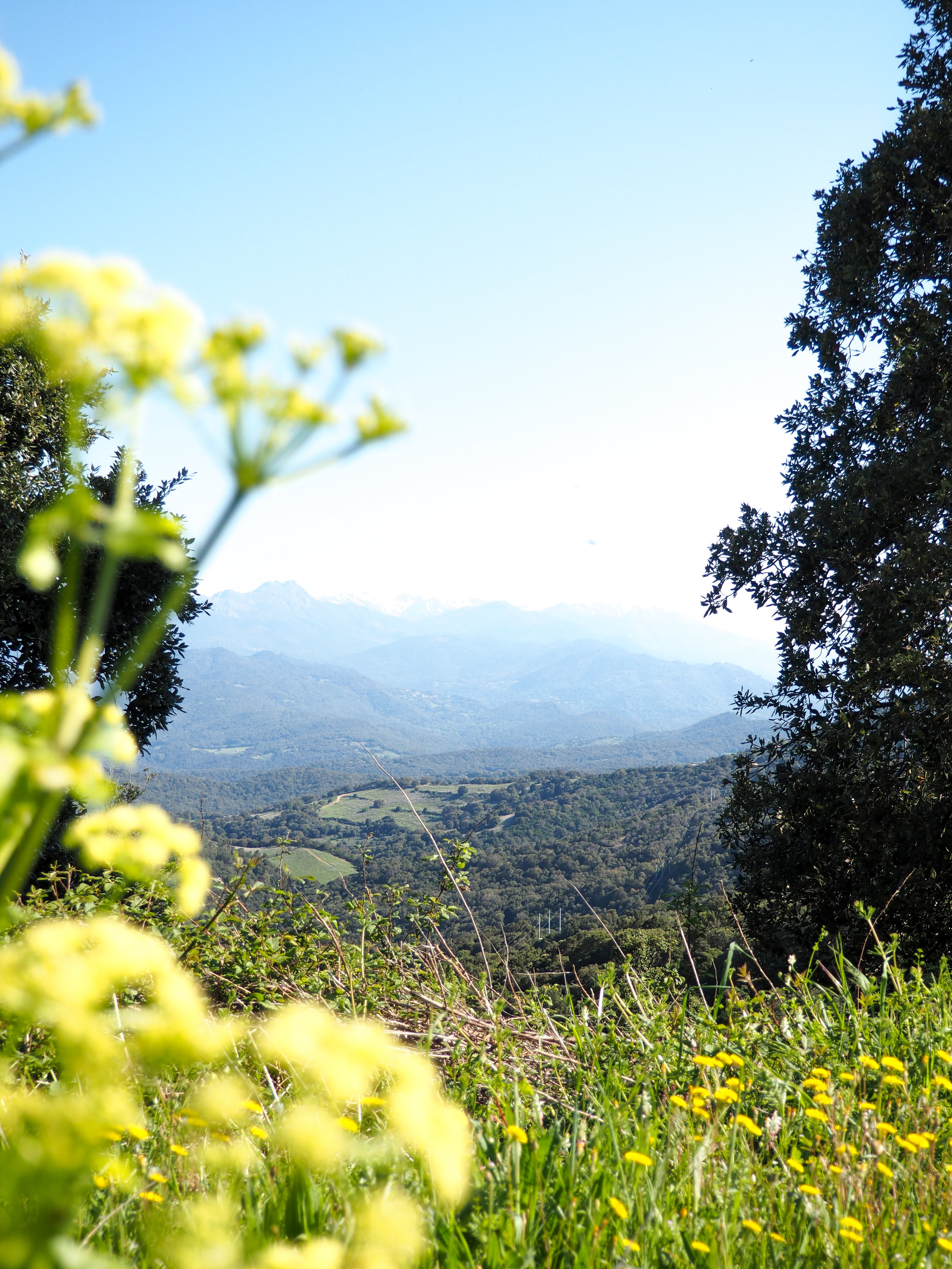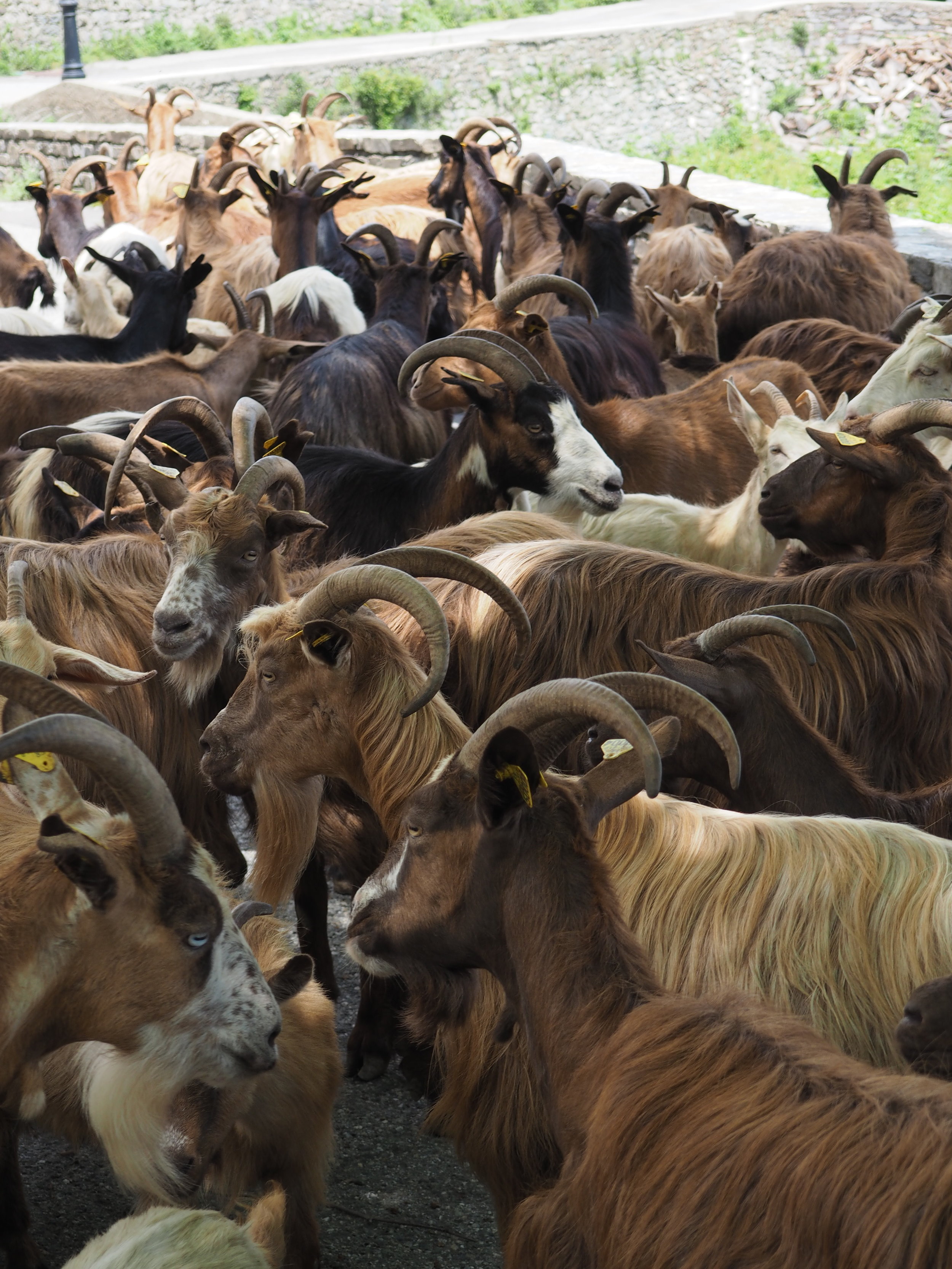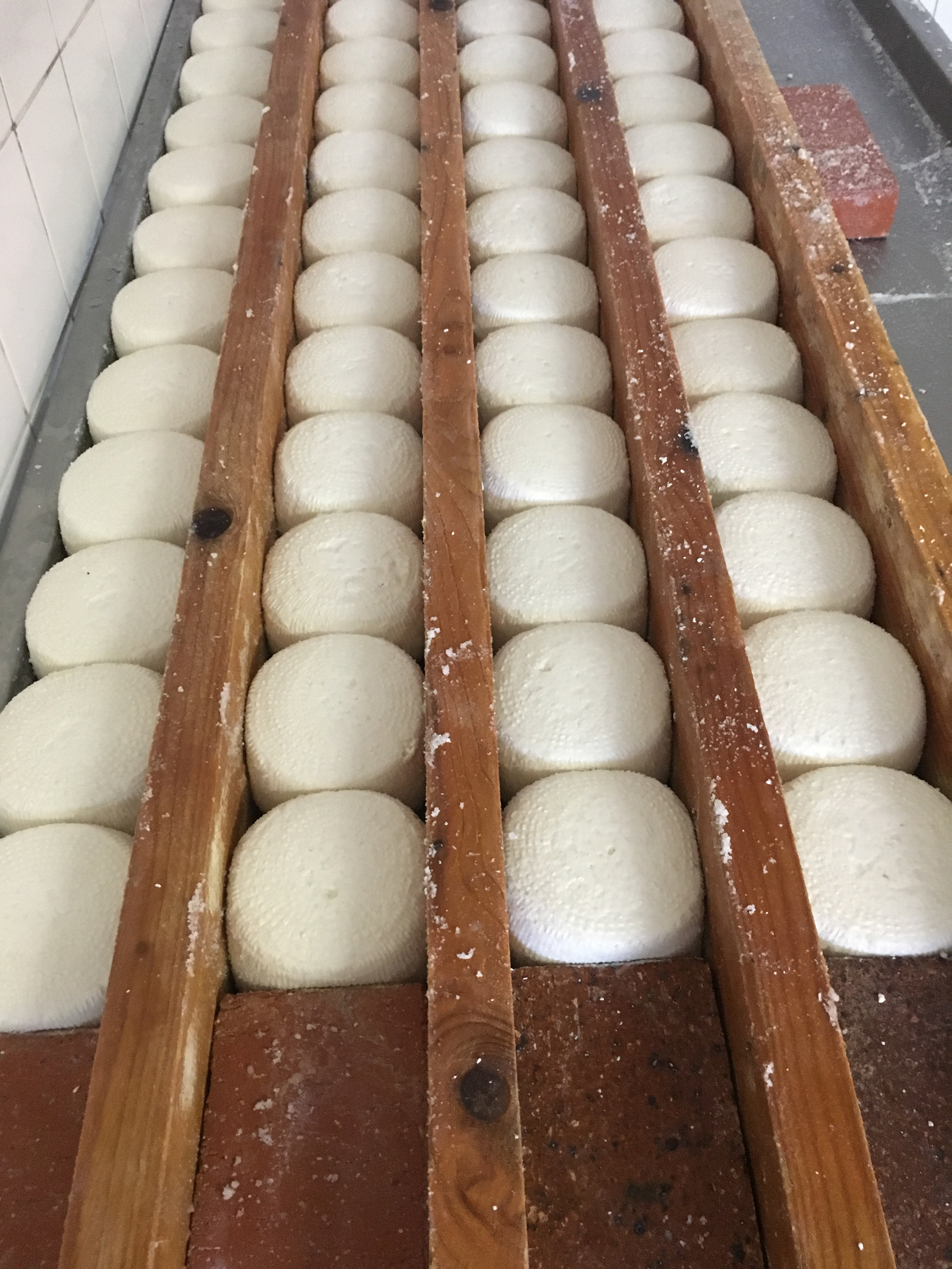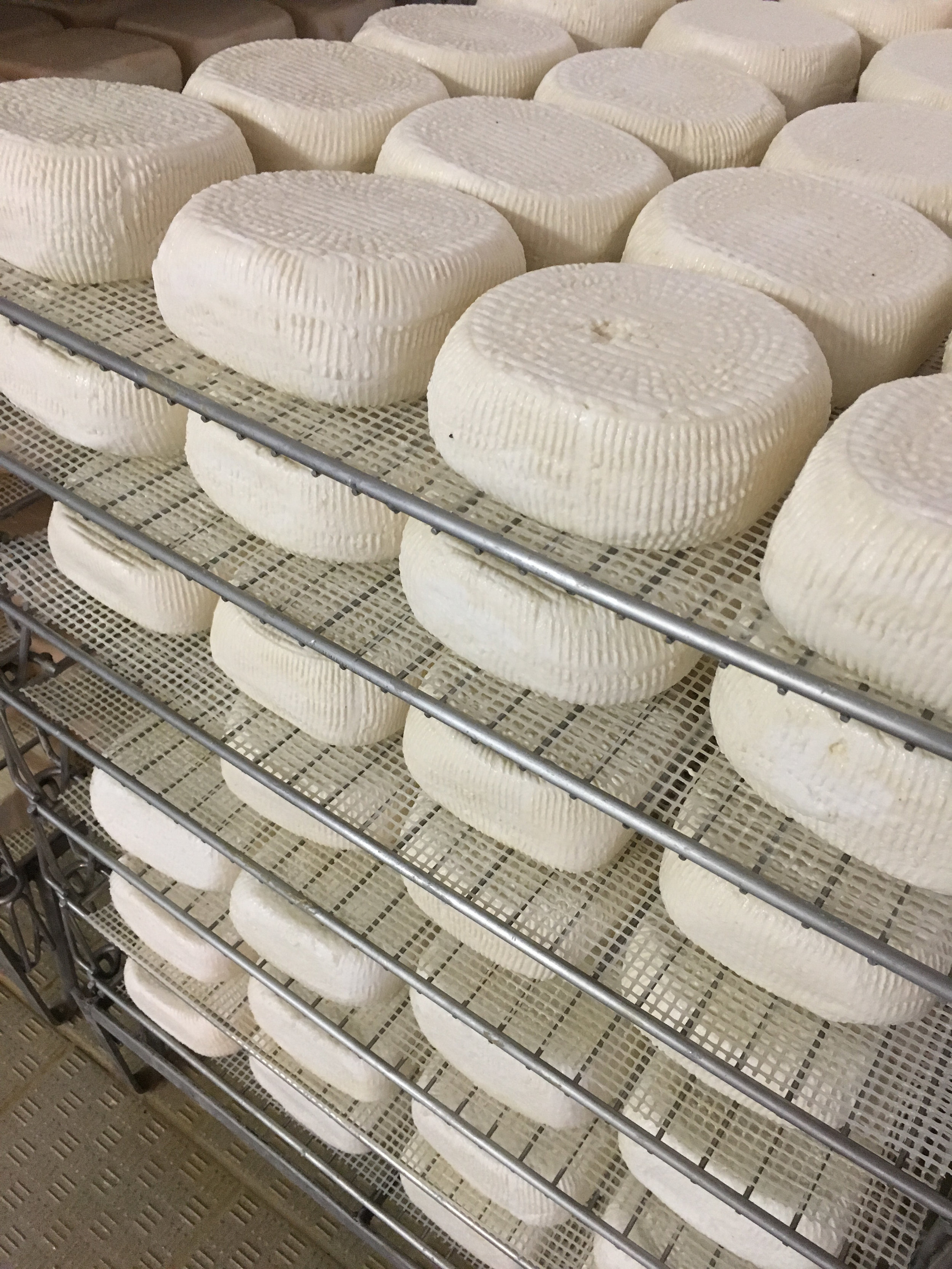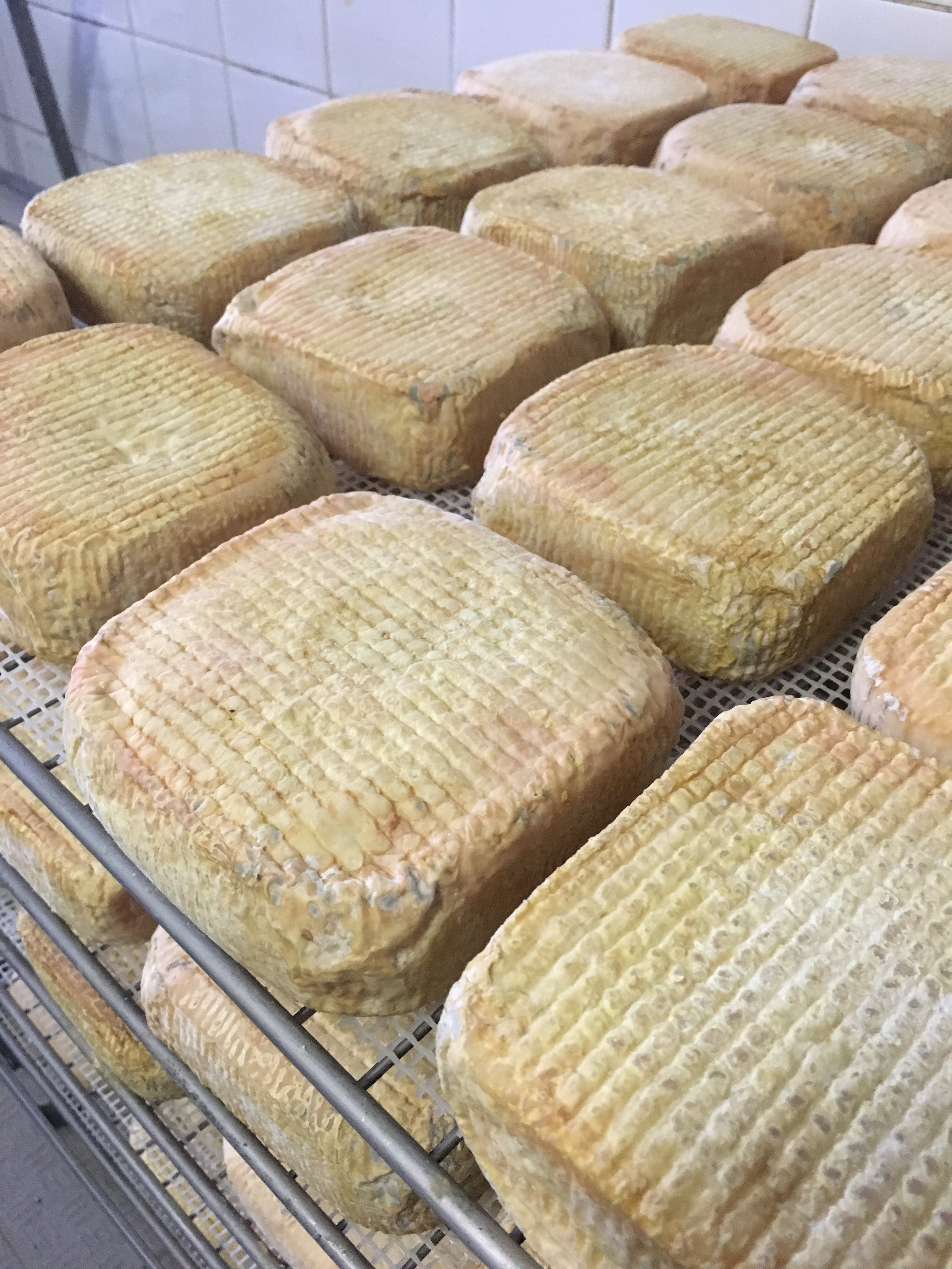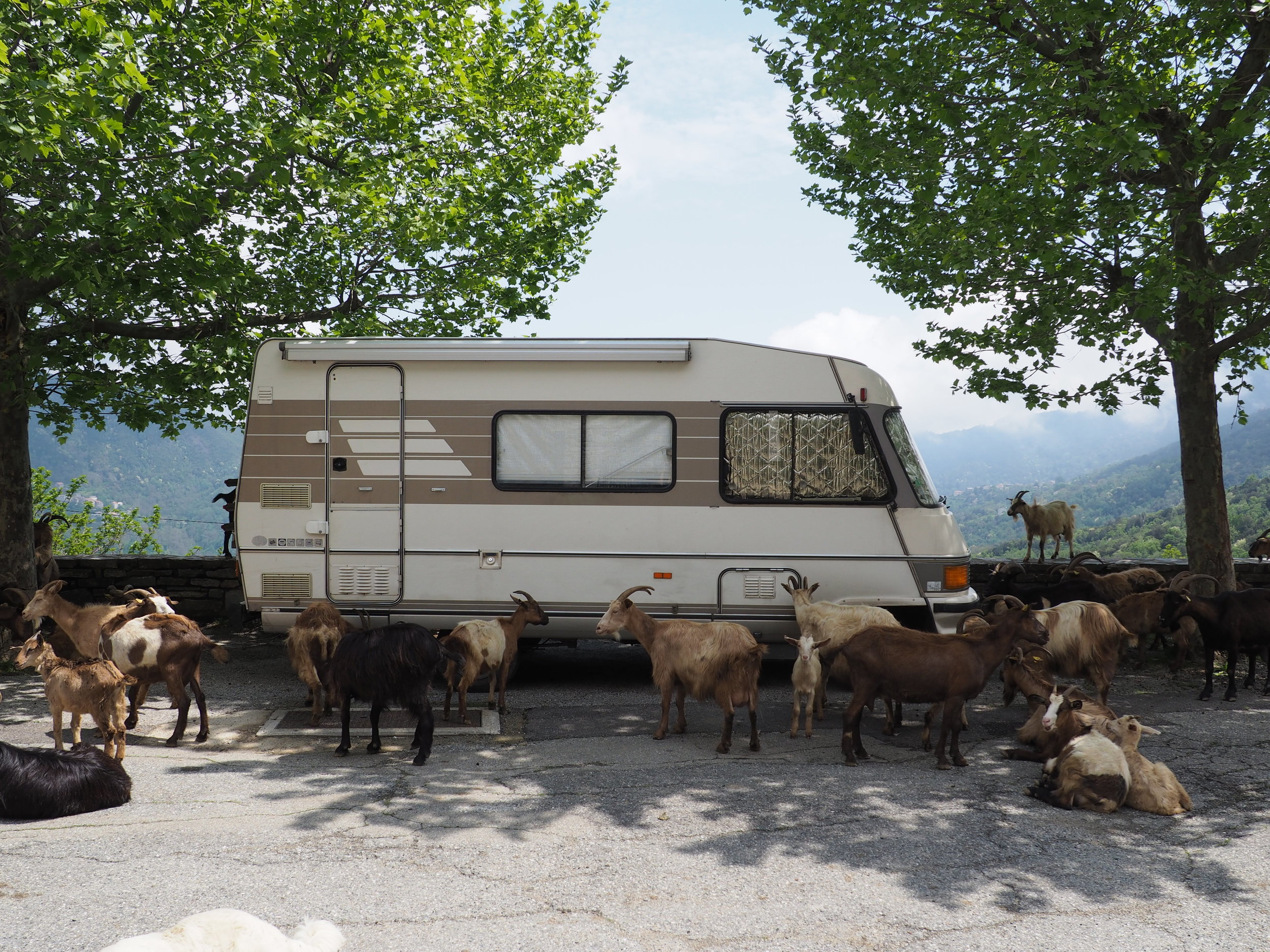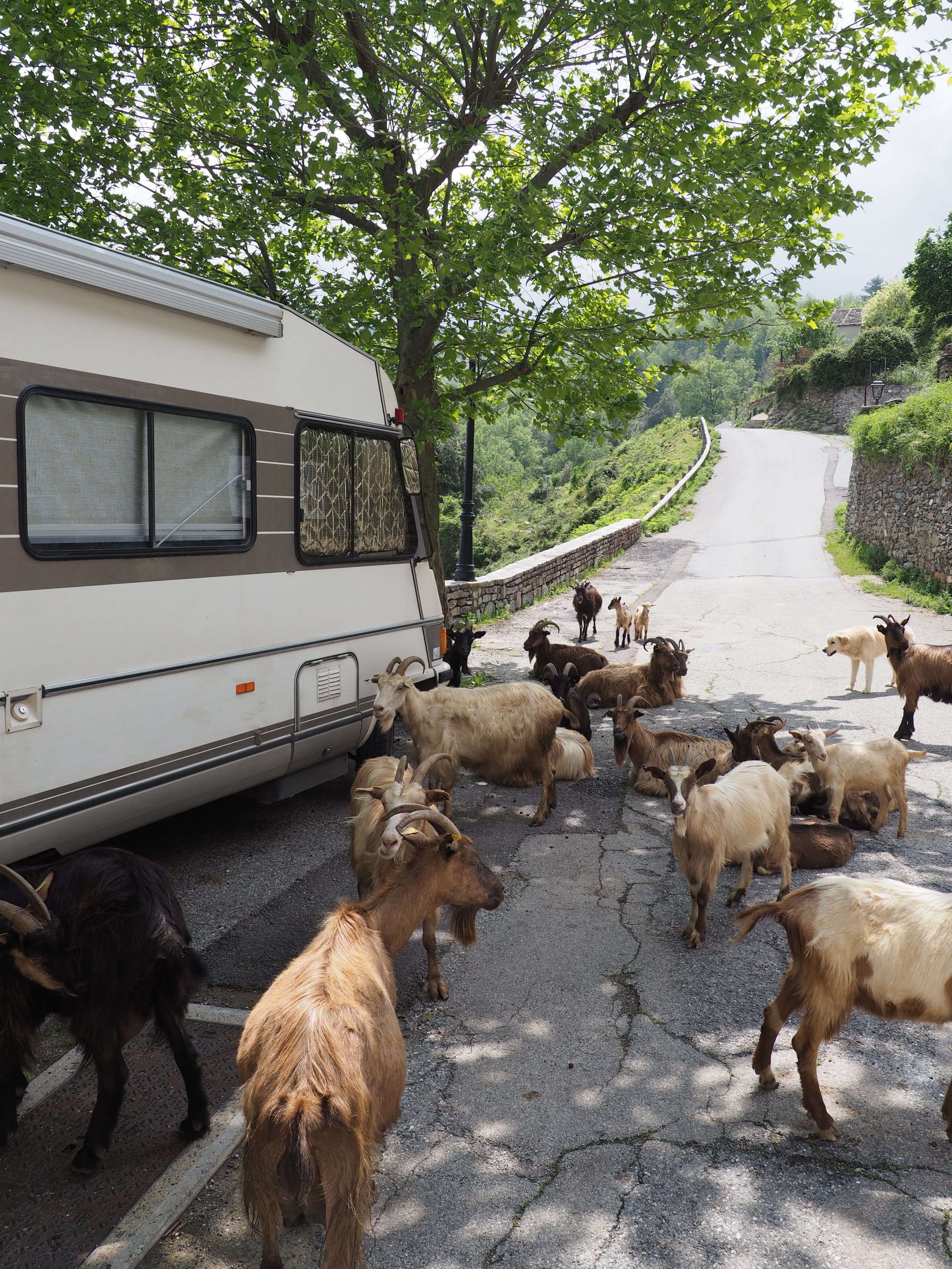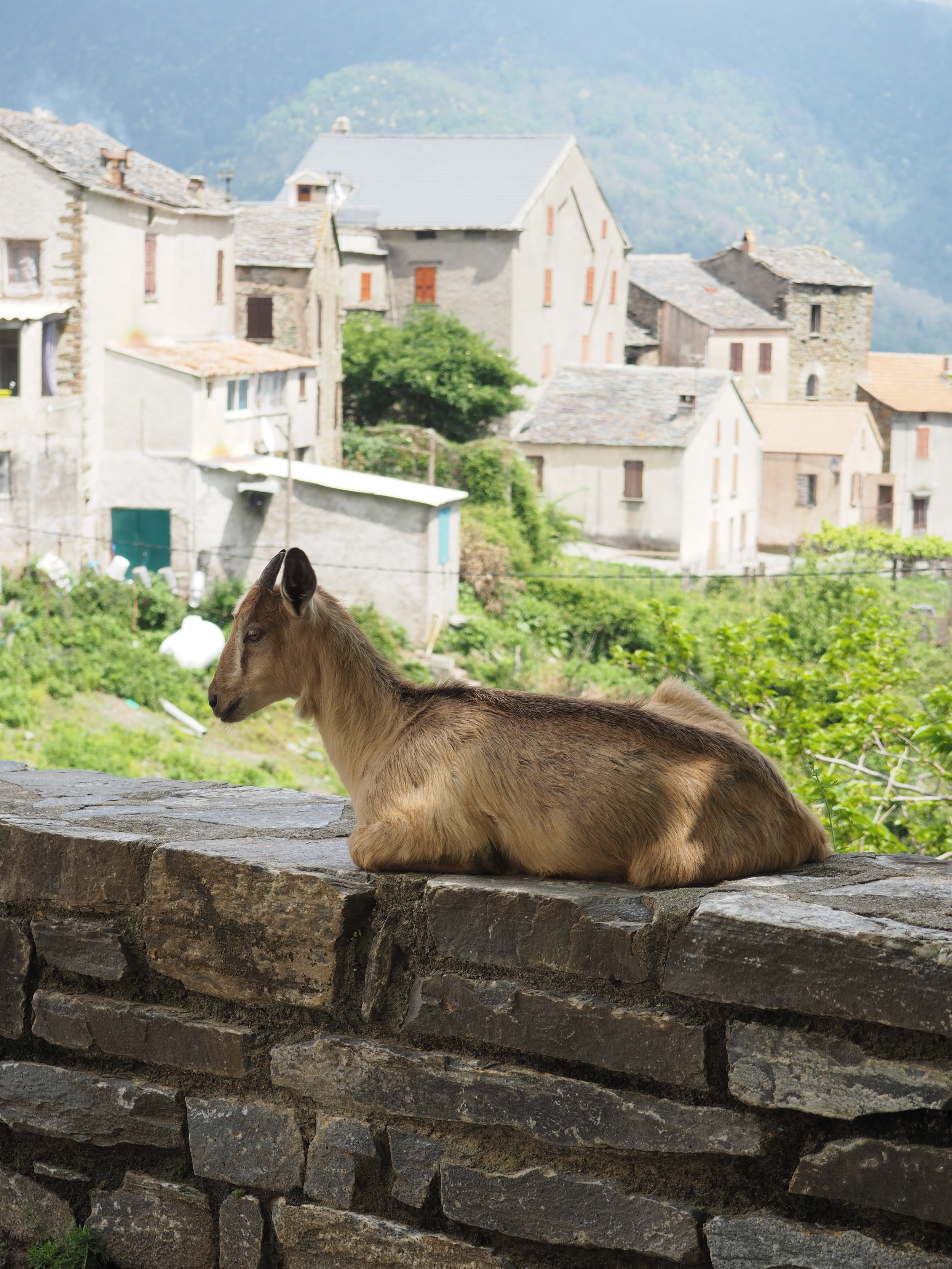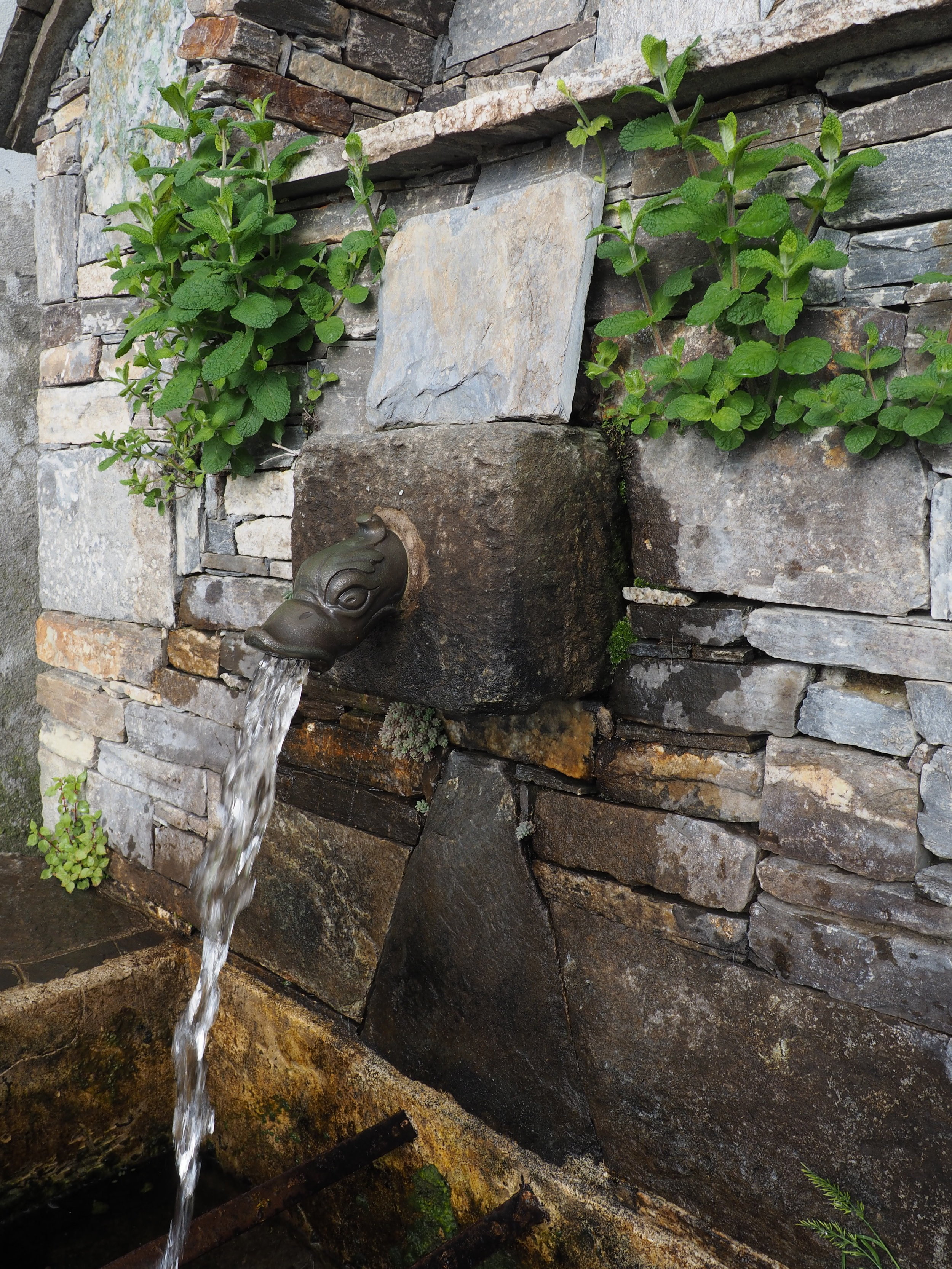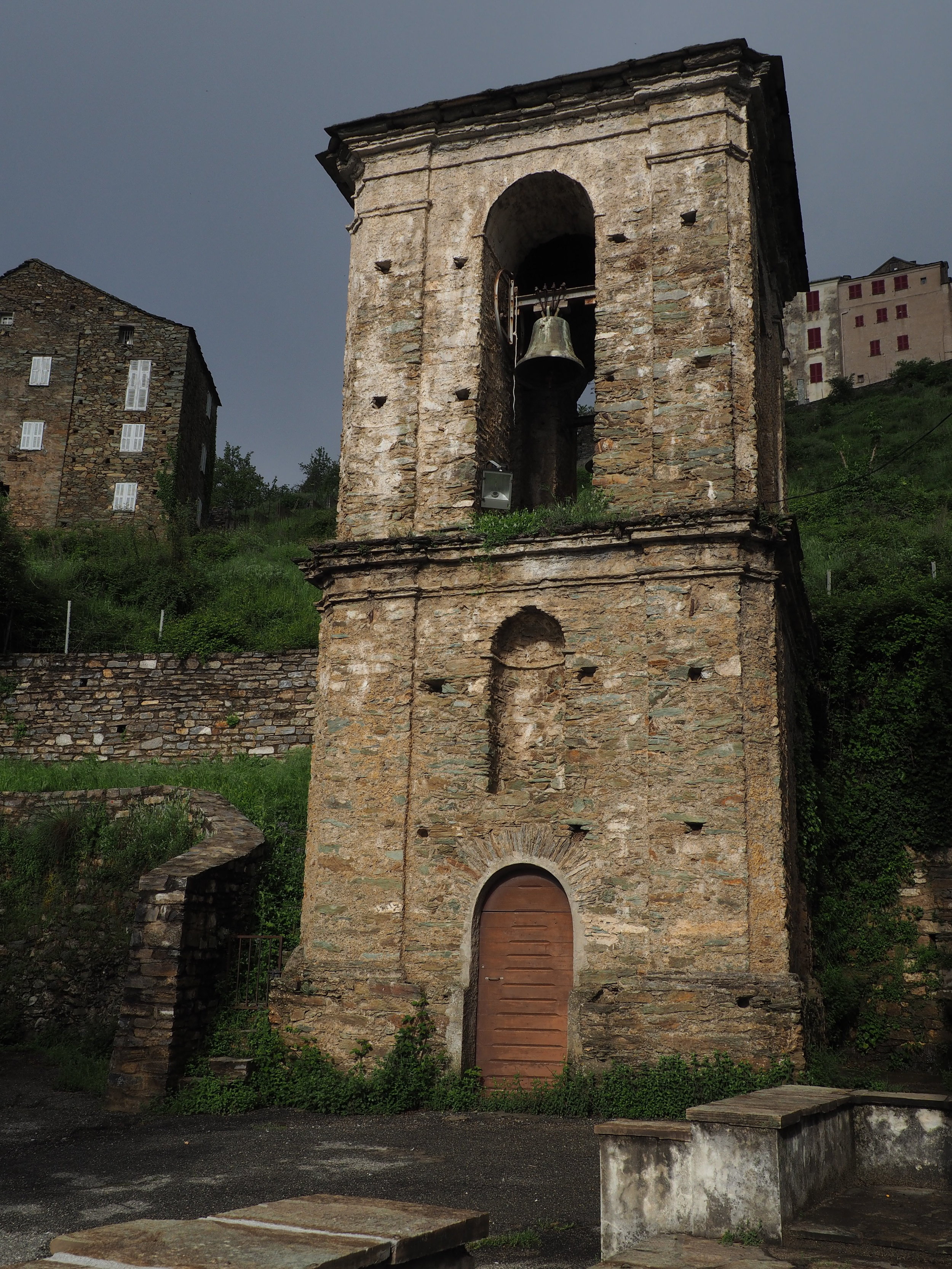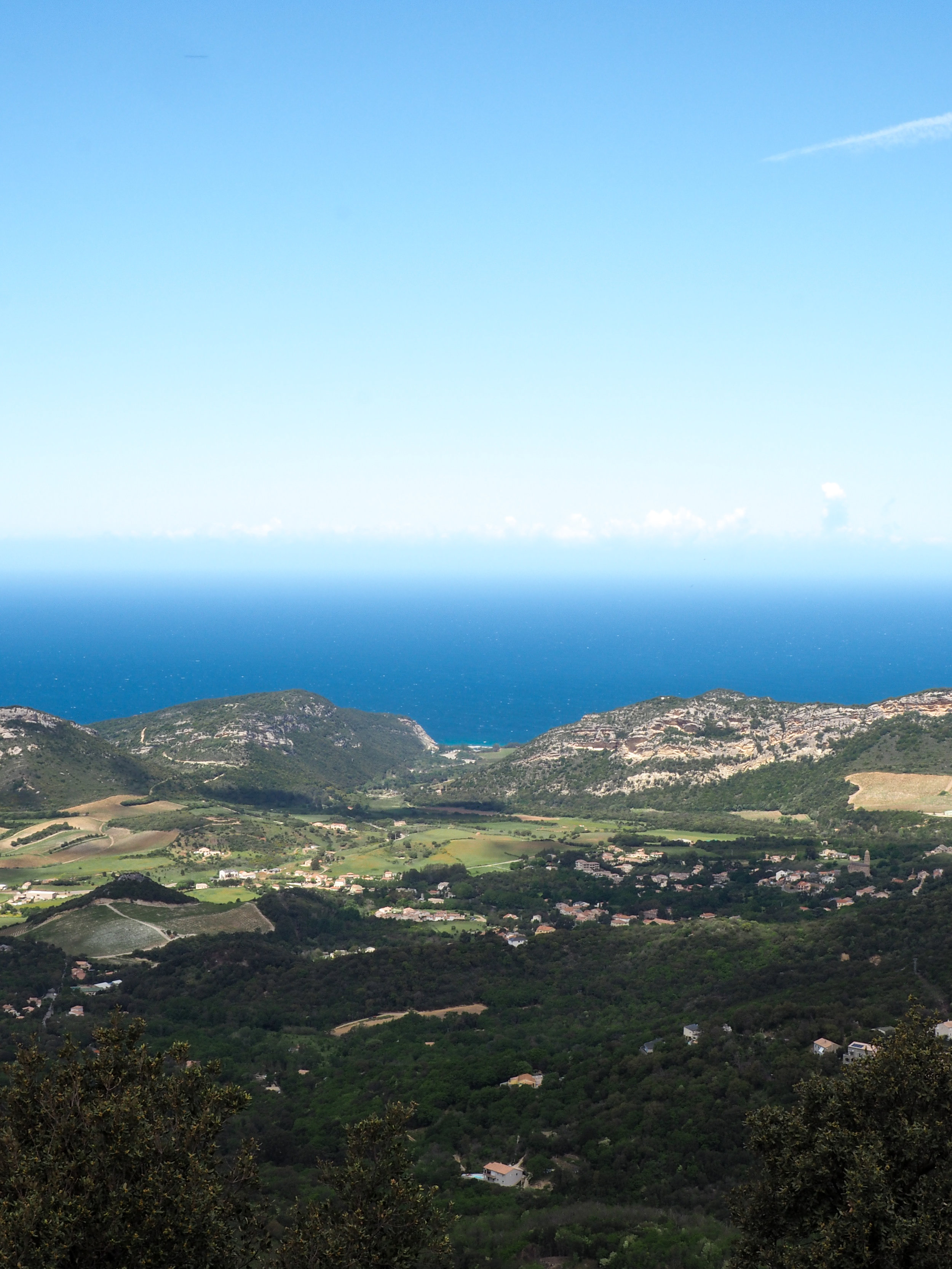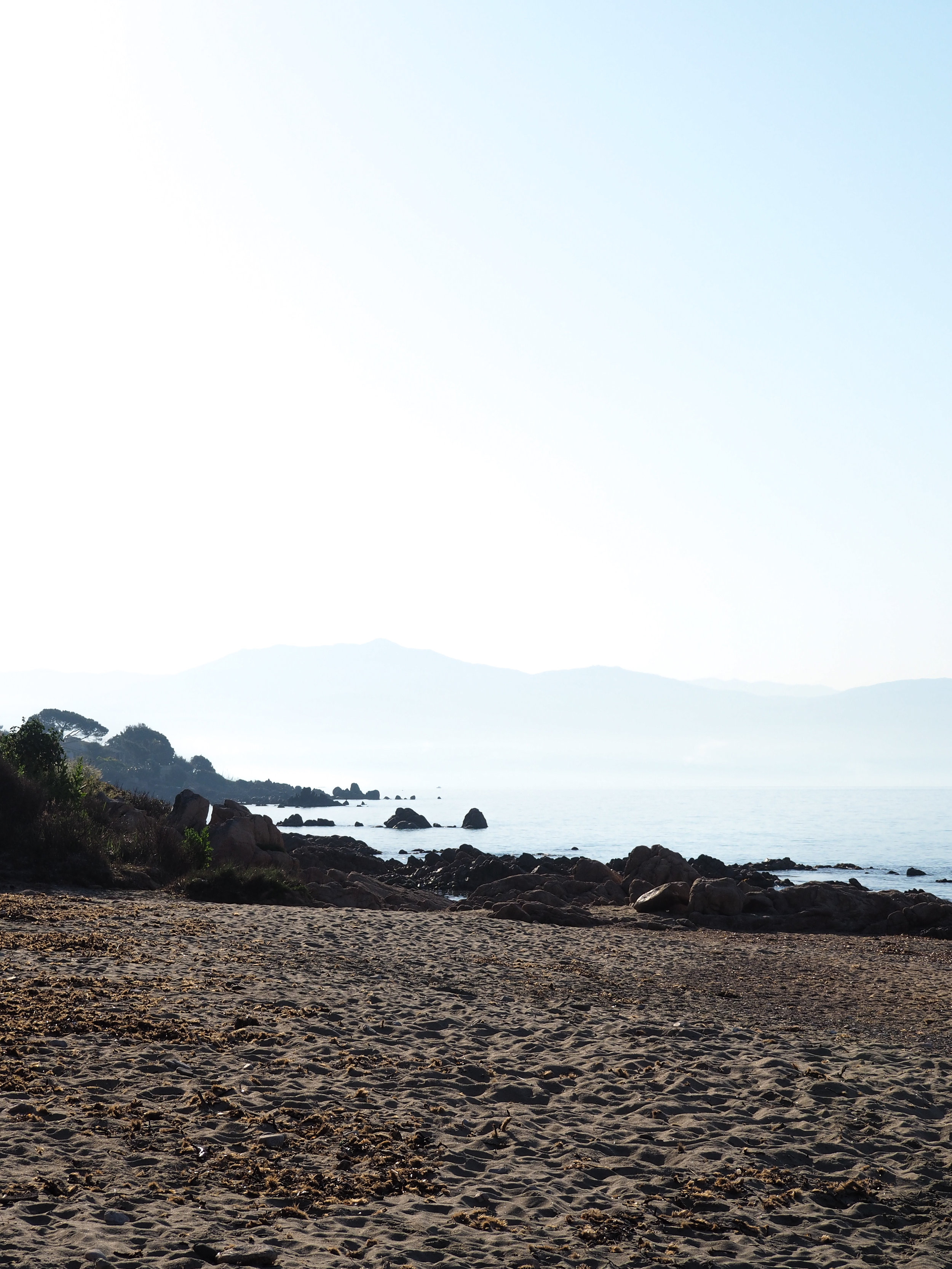Anne-Marie et Saveriu (Xavier) Santucci - Perelli, Corsica
While we were working at the Ferme d’Alzetta, I met a school teacher at the farm store during the Alzetta Community Supported Agriculture pick-up. She told me there was a goat herder, Saveriu, who had lost his entire property to a devastating fire, the majority of his 500 head herd, the entire barn complex to flames, and he and his team, including the firefighters, barely managed to escape alive. Over 100 volunteers, including many students from the University in Corte, came to rebuild the barn and round up the highly traumatised remaining goats who were scattered across the mountains. Eric and I very much wanted to help the goat herder in any way possible and the school teacher agreed to take us up into the mountains that weekend.
We were instructed to meet the school teacher at Sant'Andréa-di-Cotone and Eric skillfully drove Marcel, our camping car, up the steep and twisting Corsican mountain roads, often encountering a family of pigs, a lone cow, or a troop of goats. Upon arrival at Perelli, we were welcomed by an overwhelming scent of wild mint, a babbling spring, breathtaking views down to the ocean, and shuttered windows.
Known for their charcuterie, chestnut products, citrus, olive oil, wine, and cheese, Corsicans are protective of their artisan knowledge. This savoir faire was once crucial for self-sufficiency and survival (for example, the Genovese royaume, who formally reigned over Corsica, required each patriarch to plant a chestnut tree in order to make chestnut flour, as wheat was difficult to grow on the majority of the island, except for the Alérian plain, which was the bread-basket for ancient Rome).
Because new generations are leaving behind their hilltop villages and moving to the cities or the mainland, this traditional knowledge is subsequently becoming lost. We were extremely lucky to stay with the Santucci family, who are masters of cheesemaking with their goat’s milk, produce their own house charcuterie with their heritage Corsican pigs, and grow their own vegetables.
Waking up at the crack of dawn each day, Eric went off with Saveriu and the men to herd goats, climbing through bramble and charred forests, to find the creatures. Exhausting work, running up and down hills, chasing the quick-footed goats, my 6’4” Eric had a tough time navigating through the brush. He even carried a baby goat, who had broken his leg, all the way down the mountain. Covered in soot, the men would often return for lunch or at the end of the day, sweaty and full of stories.
I would join Anne-Marie, the matriarch, in the kitchen for a quick coffee and recap of the village gossip, and then head downstairs to make goat’s cheese. As their own goats were suffering from post-traumatic stress disorder from the fire, and therefore not producing milk until they emotionally recovered (yes, goats are very sensitive animals), we used the milk of their dear friend’s goat herd to form the fresh cheeses. The raw milk was poured and strained from 80L metal jugs into two massive metal pots. Then, rennet was added, and we waited for the curds to separate from the whey. We then strained the curds by dipping plastic cheese baskets into the pots and laid the baskets out on a slightly slanted metal table, to allow the whey to drain.
The next day, the fresh cheeses were then racked up on a second metal table, the rows of cheese pressed together by wooden beams, eventually forming the cheese into squares. Once the fresh cheeses had rested for two days, each day rubbed with coarse salt, Anne Marie would stack the cheese onto drying racks to age. Every day, the all of the aging cheeses had to be rubbed by hand with clean water and turned over onto clean plastic toiles. This procedure ensures properly aged cheese, avoiding contamination, and resulting in maximum flavor. The final product is a salty, savory orange cheese, what we called a “washed rind.”
Anne-Marie and Saveriu also taught us how to make brocciu for the family, the typical Corsican soft goat’s cheese, using the second curds from the already, previously separated whey. In good old Corsican fashion, nothing was ever wasted and every morsel savored. And the joy of tasting such fresh cheese! There are no words.
In the afternoons, Eric, Saveriu and I would take one of the family’s several 4X4 trucks up into the high mountains. Off-roading through ancient chestnut trees, planted by Saveriu’s forefathers (their family can trace their Corsican lineage to the 1700s and Saveriu has never left the island), we would feed the family of 5 wild boar babies and their mother. Even higher, we climbed to the next plateau and were welcomed by the family’s 28 or so Corsican pigs, who come at the sound of Saveriu’s Corsican baritone call.
The pigs roam free across the sharp Corsican ranges to graze on wild thyme and fallen chestnuts, giving their meat that sought-after, world-renowned Corsican flavor. Many “pinzuti,” Corsican slang for “mainlander,” believe that there are wild pigs, cows, donkeys, dogs, sheep and goats on the island. Anyone with their wits about them will tell you that every animal is spoken for and you better beware, not of the animal but of the owner.
Despite never having left the island and never completed school, Saveriu was an incredibly wise man, who only spoke French for our convenience. As a woman, it was a true privilege to be allowed to accompany the Corsican men into the mountains. Saveriu taught me how to break down entire tree trunks into fence pickets and to walk amongst the pigs, touching them as we went, without fear. He was even so proud of his teachings that one evening, around the massive dinner table, he announced that I had learned to make nice pickets and demanded that Eric show them the video of me chopping wood. Meanwhile, Saveriu can break a log into four with one arm in one fell swoop.
We felt welcomed into the clan, Anne-Marie skillfully cooking up delicacies right and left for every meal. She even prepared freshly-castrated pigs testicles from the new horde of pigs that Savieru had acquired the day before. Saveriu taught us how to make the traditional Corsican liqueur, Myrte, using local myrtle berries.
Every other evening, Saveriu drove to visit the family’s dear friend Pierre, also a goat herder. Eric and I would accompany Saveriu, Eric in the passenger seat and me in the back of the truck on a cozy seat of 20kg of corn kernels, holding onto the 60L stainless steal milk jugs.
Arriving at Pierre’s house, we were welcomed by two Corsican flags on either side of the driveway. Far off in the distance, we could hear a motor buzzing, and there was Pierre, arriving up the mountain on his tiny scooter, holding three or four 60L milk jugs skilfully balanced on his shoulders. He welcomed us in Corsican and ushered us into his dining room where cooked us freshly slaughtered boar steaks, showered us with wine and Corsican alcohols, and local cheese. The two men spoke in Corsican and we tried our very best to follow along, the goat herders sometimes pausing to teach us certain words. They told us stories of their childhood, the two boys cold and hungry in a herder hut off in the mountains, with only a tin of spoiled sardines to eat while keeping eye on their respective family’s goats.
It was an honor to spend a week with the Santucci family, learning their trades from both Saveriu and Anne-Marie, as well as their children. The Santucci family is widely respected across the Perelli mountain range; at each crossing with a local, we were warmly greeted, their eyes shining with respect for Anne-Marie and Saveriu. Anne Marie even joked that she would like to print out a photo of her hand and stick it in the windshield, so that she didn’t have to wave hello to everyone on the drive up the mountain from the grocery store.
After returning down to the flatlands, we told Corsicans of our time with the Santucci family. Each and every person assured us that we had just spent an incredibly unique and rare week with the Santucci’s. Indeed, their kind is a dying breed and Saveriu is rightly proud of everything that he and his family have created and overcome.
-Lise
Lise avait rencontré pendant notre séjour une personne qui, intéressée par ce que nous faisions et notre envie de rencontrer des artisans, nous a demandé si cela nous dirait de donner un coup de main à un berger caprin ayant vu toute sa bergerie disparaître dans les flammes d'un violent incendie. Les chèvres, libérées à temps, avaient pu se sauver dans la montagne, mais, choquées, elles ne produisaient plus de lait. Nous partons donc à la rencontre de Xavier Santucci et de sa femme Anne-Marie à Perelli, dans la Castagniccia.
Les routes sont étroites, sinueuses, ça n’est rien de le dire, jonchées de pierres à cause des éboulis, et Marcel arrive tant bien que mal à grimper au milieu de paysages à vous couper le souffle. Il prendre ses quartiers sur une petite place de village en face de l’église depuis laquelle on peut admirer toute la vallée jusqu’à la mer.
Il est des expériences qui vous marquent, qui vous enrichissent et parfois même vous font grandir, c’était une de celles-là. Je ne sais même pas par où commencer tant nous avons vécu de choses en peu de temps.
Xavier fait partie de ces rares personnes qui font tout ! Ce qui autrefois était juste une façon normale de vivre fait aujourd’hui figure d’exception, de rareté !
A quoi ressemblent les journées de Xavier. Cela commence souvent à bord de son 4X4. Nous montons un peu plus haut dans la montage, à peine un petit chemin se dessine pour nous donner la direction. N’espérez même pas vous y rendre autrement qu’à pied ou en 4X4. Nous nous arrêtons au milieu des châtaigniers centenaires, Xavier brise le silence des lieux de sa voix de stentor (il faut dire que l’homme est aussi un chanteur très respecté de polyphonie corse) et lance un appel aux cochons.
Il en vient de partout, une trentaine de cochons nous entoure et commence à se goinfrer de maïs, petit complément aux châtaignes et aux glands qu’ils trouvent dans la montagne. En un coup d’œil, Xavier sait qu'il lui en manque deux et poursuit l’appel pour les retardataires qui ne tardent pas à arriver.
Nous voilà au milieu du festin porcin ! Au bruit on dirait une forte pluie qui tombe tant les mâchoires travaillent en rythme ! Vous l’aurez compris Xavier fait sa propre charcuterie. Lonzu, figatelli, copa ... pas un dont il n’ait le secret !
Après ce spectacle , Xavier sort des coins et un merlin du pick up ! Il est temps de faire des piquets en châtaigner. Ils seront vendus et serviront à faire des clôtures. Il faut voir comment il manie l’outil. D’une main, sans efforts apparents, Xavier sépare les troncs en deux, puis en 4 ou 8 selon la taille, ils sont ensuite taillés en pointe à un rythme soutenu.
Grande appréhension quand mon tour arrive. Et là où il n’utilise qu’une main il m’en faut deux et je dois m’y reprendre à plusieurs fois. La pratique aidant je finis par faire bonne figure... mais bien moins que Lise qui manie les coins et le merlin aussi bien que les casseroles et les couteaux !
Le lendemain Lise va au laboratoire avec Anne-Marie et fabrique le fromage, pendant que Xavier, son fils, un ami de la famille, et moi partons dans le maquis à la recherche des chèvres. C’est un peu triste de passer dans ces zones brulées, c’est aussi très dur de suivre le rythme, je n’ai clairement pas le physique pour le maquis, le vrai : il nous faut ramper, passer entre les aiguilles, traverser de vraies barrières végétale ! Bref, je m’adapte, mes compagnons sont patients mais je vois bien que je les ralentis un peu.
Nous retrouvons Lise et Anne-Marie, pendant que Xavier récupère le petit lait pour faire du brocciu. Assis patiemment devant sa grande gamelle, il chauffe le petit lait, y ajoute un peu de lait frais jusqu'à ce que le caillé prenne. À l’aide d’une sorte de spatule, on dépose très délicatement le caillé dans des moules. Chose rare et délicieuse, nous pouvons goûter le brocciu à chaud. « C'est comme ça qu’il est le meilleur ! »
Nous prenons tous nos repas avec la famille, du café du matin au digestif du soir ! Anne-Marie est une excellente cuisinière et nous régale de ses plats et bien sûr de la charcuterie de Xavier et de leur fromage. Et quand Xavier lui amène les amourettes de cochon fraîchement castrés, elle se met tout de suite au fourneau pour nous régaler !
La table est toujours pleine, les amis et la famille passent, restent manger, c’est vivant, et c’est tout en corse ! Ils ne parlent français que pour nous accommoder, par gentillesse, aussi pour nous inclure ou pour nous expliquer mais clairement ici on parle corse !
Les chèvres ne produisant plus de lait pour le moment et Xavier souhaitant garder sa clientèle, il récupère le lait d’un ami d’enfance, Pierre, qui a repris l’exploitation de son frère décédé.
Une heure de route, au pas, Xavier, Lise et moi. Peut-être mes moments préférés. Là, le calme de la voiture donne le temps à Xavier de parler un peu plus des choses de la vie, des histoires du village, de la famille
Xavier n’a jamais quitté la Corse. «Pour quoi faire ? » nous répond-il. Il ne quitte la Castagniccia que pour chanter mais c’est un homme avec une connaissance et un regard sur la vie qui valent bien les discours de grand professeurs !
Sur le chemin, chaque personne que nous croisons le salut, l’homme est respecté.
Le summum de ces moments, c’est l’arrivée chez Pierre. Deux drapeaux corses battent le vent pour nous accueillir, et l'on entend au loin le bruit d’un petit moteur, c’est Pierre sur son scooter chargé de 3 pots de lait de 60kg chacun, montant des pentes que je peine à faire à pied ! "C'est une question d’habitude" et il repart en chercher autant !
Xavier et Pierre se connaissent depuis toujours, et pendant que l'on partage une eau de vie, Pierre passe en cuisine. N’imaginez même pas partir de chez lui sans qu’il vous ait reçu comme il se doit. De bons steaks d'un sanglier tué le matin, quelques pommes de terre, de la charcuterie, du fromage, et surtout leurs conversations, leurs échanges en corse, les mots qu’ils nous apprennent, les histoires qu’ils nous racontent sur leur enfance, leur jeunesse, nous avons vraiment l’impression de vivre un moment suspendu dans le temps !
Les jours se succèdent, avec à chaque fois de nouvelles découvertes. On fait la liqueur de myrte, que l'on goûte encore chaude à l’heure ou je mords d’habitude dans un croissant !
Je ne crois pas que l'on ait beaucoup aidé Xavier et Anne-Marie, j’espère juste qu’on leur a un peu changé les idées après l’incendie qui a failli leur coûter la vie. Je ne peux vous raconter tout ce que nous avons fait, ce que nous avons appris, j’ai même hésité à écrire sur cette rencontre tant elle avait quelque chose d’intime, de personnel.
Ce qui est certain c'est que ce couple nous a apporté énormément, et que nous n'avons pas quitté la Castagniccia exactement comme nous y étions arrivés.
-Eric

